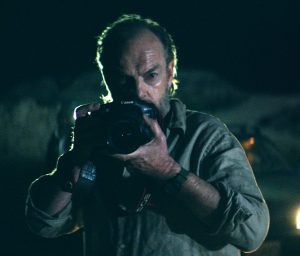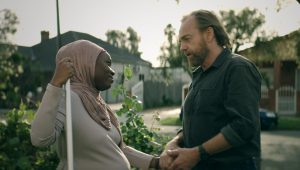Hugo Weaving stars in the feature film Hearts and Bones, the story of a war photographer, a survivor and a photo that threatens to destroy them, reviewed by Elizabeth Hughes.
It is always a pleasure to be surprised by a movie.
I attended the Sydney preview of Hearts and Bones in February this year, expecting one of a variety of now familiar storylines and wondering what more could be said about the refugee situation not already covered in cinema, books and theatre.
Well, apparently there was more to be said and I was wrong.

Ben Lawrence, whose father is celebrated Australian director, Ray Lawrence (Lantana, Bliss, Jindabyne), has previously made documentaries.
Hearts and Bones is his debut feature narrative film and it is a riveting human drama. In its exploration of the unlikely friendship between a Sudanese war refugee and a renowned war photographer, it raises a raft of complex moral issues and encourages us to put our own beliefs and attitudes under scrutiny.
The action begins before the credits appear with a dramatic night-time sequence in the Iraqi desert. Daniel Fisher (Hugo Weaving) films a scene of carnage along the roadside and impulsively makes an error of judgment that will continue to haunt him over the years. It becomes his secret, and, among other things, this film is about the corrosive effect of secrets.
Sudanese refugee Sebastian Ahmed (Andrew Luri) is driving his taxi when he hears Daniel on the radio promoting a major retrospective of his work and the accompanying book of photographs. Sebastian remembers Daniel. Their paths crossed 15 years earlier when Daniel photographed a massacre that occurred in Sebastian’s village in Sudan.
He also carries a secret and he does not want images of his village included in the exhibition.
Sebastian contacts Daniel, explaining that the photos will re-open old wounds, and the two men embark on a friendship that allows Daniel and his wife, Josie (Hayley McElhinney), entry into the rich cultural life of the Sudanese community of Western Sydney. Josie forms a relationship with Sebastian’s partner, Anishka (played with intelligence and empathy by Bolude Watson).

As Daniel’s interest in Sebastian and his friends deepens, he finds himself looking more intently at his photos of the massacre and therein lies a terrible discovery.
He now has to make a decision. What course of action should he take when the cost will be so high?
The film asks this question of Daniel and, significantly, of the audience and it provides no easy answers.
Hugo Weaving is excellent as Daniel, giving a restrained, tender performance as a vulnerable, traumatised man weighed down by the horrors of a job to which he is addicted.
Andrew Luri, who was working as a truck driver when he auditioned for the film, makes a remarkable transition from a warm family man who, unlike Daniel, yearns for a simple life to the tormented refugee in danger of losing everything.
Their performances are well supported by Hayley McElhinney and Bolude Watson. Anishka, who is expecting a child, has no idea of Sebastian’s previous life (or family). Josie is well aware of Daniel’s fragile emotional state but does not completely understand why it has further deteriorated. She and Daniel are still grieving the loss of a child caused by a condition that endangered her own life. Her announcement that she is pregnant and has decided to keep the baby without consulting him comes as a serious shock to Daniel.
The interaction between the two women is revealing. When Daniel tells Josie what he has learned about Sebastian she moves swiftly, as does her brother in law, into the role of white, middle class, entitled. When Josie visits Anishka the power imbalance is evident. Despite their friendship, the gap in their understanding of each other is wide indeed.

Lawrence’s intention was to set the film in Western Sydney and cinematographer Hugh Miller, who made the internationally acclaimed documentary Sherpa (2015), gives us a realistic depiction of street life in the western suburbs of Sydney rarely seen in recent Australian films. Equally notable are the images of faces where the camera lingers, capturing the uncertainty, hardship and despair of lives pushed to the limit.
Hearts and Bones centres on the power of the image. It raises a number of questions. How ethical is it to earn a living from photographing crimes against humanity? Should the photographer feel a sense of responsibility towards the victims in those images? To fully understand an image, is it enough for it to stand alone or must it be seen in context? These are issues of particular importance today and the film’s strength is that they are left for us to reflect upon.
Lawrence’s otherwise excellent script, co-written with Beatrix Christian (Jindabyne), ties up a little too sweetly for my taste but the impact of this complex and timely story is in no way diminished.
The final moments of the film provide us with powerful context. To the strains of Talking Heads’ Road to Nowhere we view a montage of photographs of real refugees. It is a sad, sobering reminder of the millions of people who continue to flee the unspeakable, moving with a kind of desperate hope towards arms that are not necessarily welcoming.
Hearts and Bones Hearts is available on digital platforms and stores including iTunes, GooglePlay and Koorong.
To watch the trailer, click here.
About the reviewer
Elizabeth Hughes has been a teacher librarian for 45 years in the Catholic primary system, mainly in schools with predominantly migrant children. She has a strong belief in the important role of school libraries – a good collection can help children develop a love of story, an appreciation of language and a sense of curiosity about our astonishing world.
